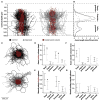Sensory experience restructures thalamocortical axons during adulthood
- PMID: 22632723
- PMCID: PMC3564553
- DOI: 10.1016/j.neuron.2012.03.022
Sensory experience restructures thalamocortical axons during adulthood
Abstract
The brain's capacity to rewire is thought to diminish with age. It is widely believed that development stabilizes the synapses from thalamus to cortex and that adult experience alters only synaptic connections between cortical neurons. Here we show that thalamocortical (TC) inputs themselves undergo massive plasticity in adults. We combined whole-cell recording from individual thalamocortical neurons in adult rats with a recently developed automatic tracing technique to reconstruct individual axonal trees. Whisker trimming substantially reduced thalamocortical axon length in barrel cortex but not the density of TC synapses along a fiber. Thus, sensory experience alters the total number of TC synapses. After trimming, sensory stimulation evoked more tightly time-locked responses among thalamorecipient layer 4 cortical neurons. These findings indicate that thalamocortical input itself remains plastic in adulthood, raising the possibility that the axons of other subcortical structures might also remain in flux throughout life.
Copyright © 2012 Elsevier Inc. All rights reserved.
Figures




Similar articles
-
Cortex is driven by weak but synchronously active thalamocortical synapses.Science. 2006 Jun 16;312(5780):1622-7. doi: 10.1126/science.1124593. Science. 2006. PMID: 16778049
-
Neurotransmitter release at the thalamocortical synapse instructs barrel formation but not axon patterning in the somatosensory cortex.J Neurosci. 2012 May 2;32(18):6183-96. doi: 10.1523/JNEUROSCI.0343-12.2012. J Neurosci. 2012. PMID: 22553025 Free PMC article.
-
Experience-Dependent, Layer-Specific Development of Divergent Thalamocortical Connectivity.Cereb Cortex. 2015 Aug;25(8):2255-66. doi: 10.1093/cercor/bhu031. Epub 2014 Mar 7. Cereb Cortex. 2015. PMID: 24610243 Free PMC article.
-
[Research progress on barrel cortex and its plasticity].Zhejiang Da Xue Xue Bao Yi Xue Ban. 2011 May;40(3):332-7. doi: 10.3785/j.issn.1008-9292.2011.03.018. Zhejiang Da Xue Xue Bao Yi Xue Ban. 2011. PMID: 21671497 Review. Chinese.
-
Synaptic biology of barrel cortex circuit assembly.Semin Cell Dev Biol. 2014 Nov;35:156-64. doi: 10.1016/j.semcdb.2014.07.009. Epub 2014 Jul 28. Semin Cell Dev Biol. 2014. PMID: 25080022 Review.
Cited by
-
Surround Integration Organizes a Spatial Map during Active Sensation.Neuron. 2017 Jun 21;94(6):1220-1233.e5. doi: 10.1016/j.neuron.2017.04.026. Epub 2017 May 11. Neuron. 2017. PMID: 28504117 Free PMC article.
-
An increase in dendritic plateau potentials is associated with experience-dependent cortical map reorganization.Proc Natl Acad Sci U S A. 2021 Mar 2;118(9):e2024920118. doi: 10.1073/pnas.2024920118. Proc Natl Acad Sci U S A. 2021. PMID: 33619110 Free PMC article.
-
Specific connectivity optimizes learning in thalamocortical loops.Cell Rep. 2024 Apr 23;43(4):114059. doi: 10.1016/j.celrep.2024.114059. Epub 2024 Apr 10. Cell Rep. 2024. PMID: 38602873 Free PMC article.
-
Activity dependent modulation of glial gap junction coupling in the thalamus.iScience. 2024 Sep 26;27(10):111043. doi: 10.1016/j.isci.2024.111043. eCollection 2024 Oct 18. iScience. 2024. PMID: 39435144 Free PMC article.
-
Reorganization of cortical population activity imaged throughout long-term sensory deprivation.Nat Neurosci. 2012 Nov;15(11):1539-46. doi: 10.1038/nn.3240. Epub 2012 Oct 21. Nat Neurosci. 2012. PMID: 23086335
References
-
- Akhtar ND, Land PW. Activity-dependent regulation of glutamic acid decarboxylase in the rat barrel cortex: effects of neonatal versus adult sensory deprivation. J Comp Neurol. 1991;307:200–213. - PubMed
-
- Antonini A, Stryker MP. Rapid remodeling of axonal arbors in the visual cortex. Science. 1993;260:1819–1821. - PubMed
-
- Arnold PB, Li CX, Waters RS. Thalamocortical arbors extend beyond single cortical barrels: an in vivo intracellular tracing study in rat. Exp Brain Res. 2001;136:152–168. - PubMed
Publication types
MeSH terms
Grants and funding
LinkOut - more resources
Full Text Sources
Other Literature Sources

